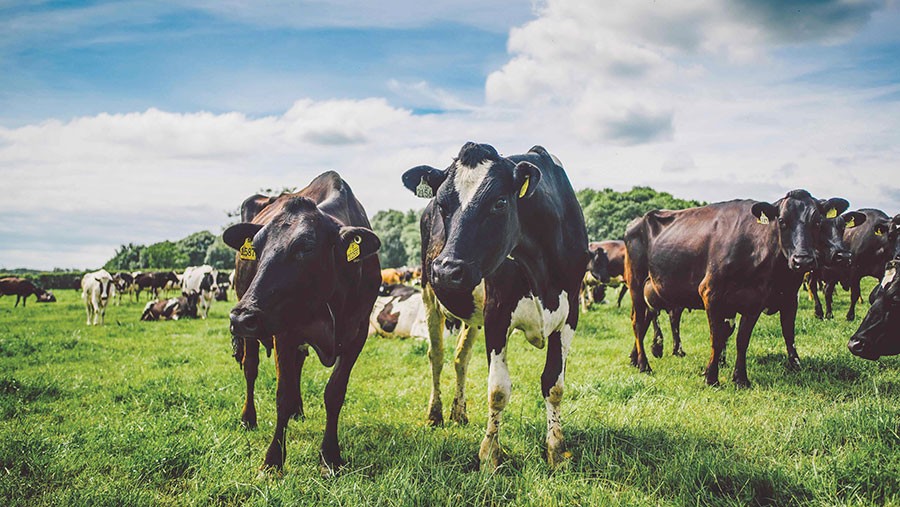
The rules, which were announced in August 2019 and came into effect on 1 January 2021, state that no healthy calf will be slaughtered or euthanised on Arla farms within the first eight weeks of life.
A survey carried out by the co-operative in the summer showed 85% of respondents were prepared for the new policy.
Alice Swift, agriculture director at Arla Foods, admits the changes have presented a significant challenge for some farmers, particularly block-calving farms with small cows or those shut down with TB with fewer outlets for calves.
However, there will now be no exceptions and all of the co-operative’s 2,300 farmers must comply, she says.
“We can’t afford to give consumers an excuse not to consume dairy. Farmers have had 18 months to comply and we have gone above and beyond to support the transition.
“The beef industry must not be seen as a dumping ground. Calves have to be fit for purpose,” adds Mrs Swift.
As well as bringing in an extra team resource to train farmers on calf health and breeding, the co-operative says it has collaborated with retailers to create integrated supply chains.
An agreement was sealed with Sainsbury’s and ABP to produce Aberdeen Angus beef for the retailer’s premium Taste the Difference range.
Another scheme has been set up with Morrisons and Buitelaar to provide Arla UK 360 farmers supplying Morrisons with an outlet for their dairy-cross calves.
Arla UK 360 farmers supplying Aldi have had to comply with the rules since January 2019 and those supplying Morrisons followed on 1 October 2019.
What has Arla done to support its farmers’ transition?
1-Breeding trials to dispel myths about using sexed semen, its reliability and bull availability.
2-Training farmers on areas such as colostrum management, health and genetics through knowledge transfer and workshops, to ensure calves get the right start.
3-Finding homes: Working closely with retailers and the beef industry to find outlets for animals.
Policing the policy
To ensure 100% compliance, farms will be audited through the Arlagarden programme, with calf movements tracked using the Cattle Tracing System (CTS). Arla will follow a “one strike and out” policy for anyone flouting the rules.
“We have more than 800 farmers waiting to join Arla and we are not recruiting. The calf can seem a cost, but to us that has the value of their milk contract,” adds Mrs Swift.
“We will be sensible. Each case will be looked at in its own right. If a farmer had a buyer in good faith and the buyer lets them down and sends them to slaughter early, they would get a warning and would get a second chance, but not a third.”
Case study: James Thompson, Sansaw Estate, Shropshire
Arla producer James Thompson has radically changed the approach to breeding on his 1,200-head spring-calving, cross-bred herd.
The business previously used conventional semen and dairy sweeper bulls and euthanised dairy bull calves, but took the decision to stop in 2018, before Arla announced the new rules.
Farm facts
-Milks 1,200 cows, with plans to expand to 1,500 over the next few seasons
-Averaged 5,000 litres a cow at 5% butterfat and 3.8% protein last year
-Farms 750ha (1,853 acres)
Mr Thompson says: “I felt it was the right thing to do. If you are shooting calves as a by-product of milking cows, it is morally wrong. As an industry we are much more visible; there are more anti-dairy campaigns.
“You can’t expect a tanker to turn up [to collect your milk] and not worry about how you farm.”
Mr Thompson has been a member of Arla’s calf working group, advising on the policy, and he believes the co-operative has made the right move, despite the challenges it presents to farm businesses such as his own.
“Arla is quite right to take the lead on this, and we want to sell our milk to a leading milk brand; I like being on that ship. Necessity is the mother of invention and we all must adjust to it.”
Making the transition
It wasn’t an easy move for his business to make – they have small-stature cows that are block-calved in the spring and face TB restrictions. However, Mr Thompson says they have faced up to it to the best of their ability.
The first step was changing their breeding programme. Last season, heifers were synchronised and served to sexed dairy semen at first service. Only the best cows (200 straws in total) were artificially inseminated to sexed semen at first service.
During the fifth week of mating, animals received Hereford semen to distinguish dairy-crosses and beef-sired calves. Then they were put in with Hereford and Angus sweeper bulls for the remaining five weeks of the mating period.
Calves
A TB isolation unit was set up in an existing building to accommodate beef calves. It cost £150,000 to retrofit gates, concrete panels and install fans and gale breakers.
In the first two months about 300 calves were offloaded to direct buyers before and after weaning to make room in the shed, with the remaining 500 beef animals taken through to six months.
Calves were reared on milk powder for eight weeks in pens of 10 and weaned once they were eating 2kg/day of a rearing nut. They later transitioned on to a growing nut plus straw.
After two clear TB tests, the six-month-old weanlings were sold at an on-farm sale through auctioneers Barbers, with 500 averaging £420 apiece.
Future
Confidence in conception rates has encouraged them to use sexed semen on 1,200 cows plus heifers this spring, using natural heats alone.
The problem last season was they all came back in heat at the same time and the bulls couldn’t cope, Mr Thompson explains.
“We have a good team who are good at heat detection and we think we will achieve better results [without synchronisation]. I hate interfering with cows – I fundamentally don’t agree with it and we have fertile cows in our herd.”
When taking into account shed depreciation, infrastructure, labour, feed, bedding, vet and medicine costs and sundries, they broke even, meeting their year one objective.
But Mr Thompson is confident that reductions in drug use and selling animals earlier will improve margins.
“We have faith that we are one year ahead of other people who are just having to come to terms with this, and we know where we can make gains. As soon as we get the green light for TB, we will sell calves the next day in future.”

























